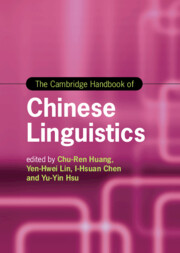Book contents
- The Cambridge Handbook of Chinese Linguistics
- Cambridge Handbooks In Language and Linguistics
- The Cambridge Handbook of Chinese Linguistics
- Copyright page
- Contents
- Figures
- Tables
- Contributors
- Acknowledgments
- Part One Writing System/Neuro-cognitive Processing of Chinese
- Part Two Morpho-lexical Issues in Chinese
- 3 Wordhood and Disyllabicity in Chinese
- 4 Characters as Basic Lexical Units and Monosyllabicity in Chinese
- 5 Parts of Speech in Chinese and How to Identify Them
- 6 Gaps in Parts of Speech in Chinese and Why?
- 7 Derivational and Inflectional Affixes in Chinese and Their Morphosyntactic Properties
- 8 The Extreme Poverty of Affixation in Chinese
- 9 On an Integral Theory of Word Formation in Chinese and Beyond
- 10 Compounding Is Semantics-driven in Chinese
- Part Three Phonetic-phonological Issues in Chinese
- Part Four Syntax-semantics, Pragmatics, and Discourse Issues
- Index
- References
8 - The Extreme Poverty of Affixation in Chinese
Rarely Derivational and Hardly Affixational
from Part Two - Morpho-lexical Issues in Chinese
Published online by Cambridge University Press: 04 August 2022
- The Cambridge Handbook of Chinese Linguistics
- Cambridge Handbooks In Language and Linguistics
- The Cambridge Handbook of Chinese Linguistics
- Copyright page
- Contents
- Figures
- Tables
- Contributors
- Acknowledgments
- Part One Writing System/Neuro-cognitive Processing of Chinese
- Part Two Morpho-lexical Issues in Chinese
- 3 Wordhood and Disyllabicity in Chinese
- 4 Characters as Basic Lexical Units and Monosyllabicity in Chinese
- 5 Parts of Speech in Chinese and How to Identify Them
- 6 Gaps in Parts of Speech in Chinese and Why?
- 7 Derivational and Inflectional Affixes in Chinese and Their Morphosyntactic Properties
- 8 The Extreme Poverty of Affixation in Chinese
- 9 On an Integral Theory of Word Formation in Chinese and Beyond
- 10 Compounding Is Semantics-driven in Chinese
- Part Three Phonetic-phonological Issues in Chinese
- Part Four Syntax-semantics, Pragmatics, and Discourse Issues
- Index
- References
Summary
This chapter explores the morphological poverty of the Chinese from an empirical perspective. Until recently, the nature of affixation in Chinese is still not well recognized and has been one of the hotly debated topics in Chinese morphology. Based on the CKIP Morphological Database (incl. 4025 “affixes” in Chinese), this chapter covers the issue of the lack of affixation in Chinese based on a range of linguistic facts and empirical arguments such as lack of productivity and irregularities in word-formation rules.
- Type
- Chapter
- Information
- The Cambridge Handbook of Chinese Linguistics , pp. 158 - 173Publisher: Cambridge University PressPrint publication year: 2022
References
- 1
- Cited by

